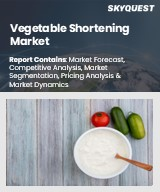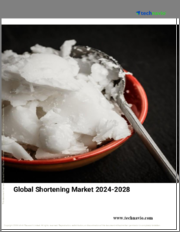
|
시장보고서
상품코드
1838221
세계의 채소 쇼트닝 시장 : 규모, 점유율, 성장 분석 - 등급별, 유형별, 형상별, 지역별 산업 예측(2025-2032년)Vegetable Shortening Market Size, Share, and Growth Analysis, By Grade (Standard Grade, Premium Grade), By Type (Palm Oil-Based Vegetable Shortening, Soybean Oil-Based Vegetable Shortening), By Form, By Region - Industry Forecast 2025-2032 |
||||||
세계의 채소 쇼트닝 시장 규모는 2023년 158억 달러로 평가되었으며, 2024년 165억 달러에서 2032년까지 232억 8,000만 달러로 성장하며 예측 기간 중(2025-2032년) CAGR 4.4%로 성장할 전망입니다.
세계의 채소 쇼트닝 시장은 베이커리, 과자류, 포장 식품 분야 수요 증가에 힘입어 빠르게 진화하고 있습니다. 식물 유래로 트랜스지방산을 포함하지 않는 대체 식품으로의 전환이, 팜, 콩, 해바라기 등 보다 건강한 기름을 사용한 기술 혁신을 제조업체에 촉진하고 있습니다. 편리하고 빨리 먹을 수 있는 베이커리 아이템에 대한 소비자의 기호는 도시와 준도시에서의 이용을 가속시키고 있습니다. 또한 견조한 외식산업과 신흥경제권에서 튀긴 과자와 구운 과자의 인기가 높아져 제품의 보급을 뒷받침하고 있습니다. 클린 라벨과 지속 가능한 동향은 큰 성장 가능성을 지니고 있지만, 저지방 지향으로의 전환을 촉진하는 건강 지향의 상승, 원료 가격의 변동, 제조업체에 혁신적이고 지속 가능한 솔루션을 요구하는 엄격한 규제 압력 등의 과제에 직면하고 있습니다.
자주 묻는 질문
목차
소개
- 조사의 목적
- 조사 범위
- 정의
조사 방법
- 정보 조달
- 2차와 1차 데이터의 방법
- 시장 규모 예측
- 시장의 전제조건과 제한
주요 요약
- 세계 시장 전망
- 공급과 수요 동향 분석
- 부문별 기회 분석
시장 역학과 전망
- 시장 개요
- 시장 규모
- 시장 역학
- 성장 촉진요인과 기회
- 억제요인과 과제
- Porter's Five Forces 분석
주요 시장 인사이트
- 중요성공요인
- 경쟁도
- 주요 투자 기회
- 시장 생태계
- 시장의 매력 지수(2024년)
- PESTEL 분석
- 거시경제지표
- 밸류체인 분석
- 가격 분석
채소 쇼트닝 시장 규모 : 등급별, CAGR(2025-2032)
- 시장 개요
- 표준 등급
- 프리미엄 등급
- 마스터 등급
채소 쇼트닝 시장 규모 : 유형별, CAGR(2025-2032)
- 시장 개요
- 팜유 베이스 채소 쇼트닝
- 대두유 베이스 채소 쇼트닝
- 캐놀라 오일 베이스 채소 쇼트닝
- 기타 식물성 기름 베이스 채소 쇼트닝
채소 쇼트닝 시장 규모 : 형태별, CAGR(2025-2032)
- 시장 개요
- 액체
- 반고체
채소 쇼트닝 시장 규모, CAGR(2025-2032)
- 북미
- 미국
- 캐나다
- 유럽
- 독일
- 스페인
- 프랑스
- 영국
- 이탈리아
- 기타 유럽
- 아시아태평양
- 중국
- 인도
- 일본
- 한국
- 기타 아시아태평양
- 라틴아메리카
- 브라질
- 기타 라틴아메리카
- 중동 및 아프리카
- GCC 국가
- 남아프리카
- 기타 중동 및 아프리카
경쟁 정보
- 상위 5개사 비교
- 주요 기업의 시장 포지셔닝(2024년)
- 주요 시장 기업이 채용한 전략
- 최근 시장 동향
- 기업의 시장 점유율 분석(2024년)
- 주요 기업의 기업 프로파일
- 기업의 상세
- 제품 포트폴리오 분석
- 기업의 부문별 점유율 분석
- 수익의 전년대비 비교(2022-2024년)
주요 기업 프로파일
- Cargill, Inc.(USA)
- Archer Daniels Midland Company(ADM)(USA)
- Wilmar International Limited(Singapore)
- Bunge Limited(USA)
- ConAgra Brands(USA)
- Ventura Foods(USA)
- JM Smucker Company(USA)
- Nutiva Inc.(USA)
- NMGK Group Company(Russia)
- AAK AB(Sweden)
- BASF SE(Germany)
- FMC Corporation(USA)
- Enza Zaden(Netherlands)
- KWS SAAT SE(Germany)
- Bayer AG(Germany)
- Groupe Limagrain(France)
- Corteva Agriscience(USA)
- Dijamant DOO(Serbia)
- TK Group of Industries(Bangladesh)
- M. Dias Branco SA(Brazil)
결론과 권고
JHS 25.10.22Global Vegetable Shortening Market size was valued at USD 15.8 billion in 2023 and is poised to grow from USD 16.5 billion in 2024 to USD 23.28 billion by 2032, growing at a CAGR of 4.4% during the forecast period (2025-2032).
The global vegetable shortening market is evolving rapidly, fueled by rising demand in bakery, confectionery, and packaged food sectors. The shift towards plant-based and trans-fat-free alternatives has prompted manufacturers to innovate using healthier oils such as palm, soy, and sunflower. Consumer preference for convenient, ready-to-eat bakery items has accelerated usage in urban and semi-urban regions. Additionally, a robust food service industry and growing popularity of fried and baked snacks in emerging economies have bolstered product reach. Despite significant growth potential from clean-label and sustainable trends, the market faces challenges, including increased health consciousness driving a shift towards low-fat options, volatility in raw material prices, and stringent regulatory pressures that compel manufacturers to seek innovative, sustainable solutions.
Top-down and bottom-up approaches were used to estimate and validate the size of the Global Vegetable Shortening market and to estimate the size of various other dependent submarkets. The research methodology used to estimate the market size includes the following details: The key players in the market were identified through secondary research, and their market shares in the respective regions were determined through primary and secondary research. This entire procedure includes the study of the annual and financial reports of the top market players and extensive interviews for key insights from industry leaders such as CEOs, VPs, directors, and marketing executives. All percentage shares split, and breakdowns were determined using secondary sources and verified through Primary sources. All possible parameters that affect the markets covered in this research study have been accounted for, viewed in extensive detail, verified through primary research, and analyzed to get the final quantitative and qualitative data.
Global Vegetable Shortening Market Segments Analysis
Global Vegetable Shortening Market is segmented by Grade, Type, Form and region. Based on Grade, the market is segmented into Standard Grade, Premium Grade and Master Grade. Based on Type, the market is segmented into Palm Oil-Based Vegetable Shortening, Soybean Oil-Based Vegetable Shortening, Canola Oil-Based Vegetable Shortening and Other Vegetable Oils-Based Vegetable Shortening. Based on Form, the market is segmented into Liquid and Semi-Solid. Based on region, the market is segmented into North America, Europe, Asia Pacific, Latin America and Middle East & Africa.
Driver of the Global Vegetable Shortening Market
The global vegetable shortening market is significantly influenced by urbanization and the fast-paced lifestyles of consumers, leading to a heightened demand for convenience foods such as baked goods and ready-to-eat snacks, which are often made with vegetable shortening. Manufacturers favor vegetable shortening due to its ability to provide the desired texture and its extended shelf life, thereby enhancing product appeal and driving sales. Additionally, the expansion of the food service sector further contributes to the growth of this market, as more establishments seek high-quality ingredients that meet consumer preferences for convenience and taste.
Restraints in the Global Vegetable Shortening Market
The Global Vegetable Shortening market faces significant challenges due to the volatility of raw material prices, particularly for palm oil, soybean oil, and other vegetable oils. This instability is influenced by various factors, including climate fluctuations, geopolitical tensions, and disruptions within supply chains. As the prices of these key commodities fluctuate, manufacturers encounter difficulties in maintaining stable production costs, which in turn complicates their ability to keep product pricing and profit margins consistent. This unpredictability can hinder growth and planning within the market, posing a considerable restraint on business operations and long-term strategies.
Market Trends of the Global Vegetable Shortening Market
The Global Vegetable Shortening market is witnessing a notable shift towards clean-label and non-GMO products, reflecting a growing consumer preference for transparency and healthier ingredients. As awareness around health and sustainability continues to rise, food manufacturers are responding by reformulating products to align with these demands, aiming for healthier yet affordable options. This trend is particularly strong in regions like North America and Europe, where consumers are increasingly insistent on knowing the source and integrity of the ingredients they consume. Consequently, plant-based shortenings with clear certifications are becoming a key focus for brands aiming to enhance their market appeal and compliance with stringent food regulations.
Table of Contents
Introduction
- Objectives of the Study
- Scope of the Report
- Definitions
Research Methodology
- Information Procurement
- Secondary & Primary Data Methods
- Market Size Estimation
- Market Assumptions & Limitations
Executive Summary
- Global Market Outlook
- Supply & Demand Trend Analysis
- Segmental Opportunity Analysis
Market Dynamics & Outlook
- Market Overview
- Market Size
- Market Dynamics
- Drivers & Opportunities
- Restraints & Challenges
- Porters Analysis
- Competitive rivalry
- Threat of substitute
- Bargaining power of buyers
- Threat of new entrants
- Bargaining power of suppliers
Key Market Insights
- Key Success Factors
- Degree of Competition
- Top Investment Pockets
- Market Ecosystem
- Market Attractiveness Index, 2024
- PESTEL Analysis
- Macro-Economic Indicators
- Value Chain Analysis
- Pricing Analysis
Global Vegetable Shortening Market Size by Grade & CAGR (2025-2032)
- Market Overview
- Standard Grade
- Premium Grade
- Master Grade
Global Vegetable Shortening Market Size by Type & CAGR (2025-2032)
- Market Overview
- Palm Oil-Based Vegetable Shortening
- Soybean Oil-Based Vegetable Shortening
- Canola Oil-Based Vegetable Shortening
- Other Vegetable Oils-Based Vegetable Shortening
Global Vegetable Shortening Market Size by Form & CAGR (2025-2032)
- Market Overview
- Liquid
- Semi-Solid
Global Vegetable Shortening Market Size & CAGR (2025-2032)
- North America (Grade, Type, Form)
- US
- Canada
- Europe (Grade, Type, Form)
- Germany
- Spain
- France
- UK
- Italy
- Rest of Europe
- Asia Pacific (Grade, Type, Form)
- China
- India
- Japan
- South Korea
- Rest of Asia-Pacific
- Latin America (Grade, Type, Form)
- Brazil
- Rest of Latin America
- Middle East & Africa (Grade, Type, Form)
- GCC Countries
- South Africa
- Rest of Middle East & Africa
Competitive Intelligence
- Top 5 Player Comparison
- Market Positioning of Key Players, 2024
- Strategies Adopted by Key Market Players
- Recent Developments in the Market
- Company Market Share Analysis, 2024
- Company Profiles of All Key Players
- Company Details
- Product Portfolio Analysis
- Company's Segmental Share Analysis
- Revenue Y-O-Y Comparison (2022-2024)
Key Company Profiles
- Cargill, Inc. (USA)
- Company Overview
- Business Segment Overview
- Financial Updates
- Key Developments
- Archer Daniels Midland Company (ADM) (USA)
- Company Overview
- Business Segment Overview
- Financial Updates
- Key Developments
- Wilmar International Limited (Singapore)
- Company Overview
- Business Segment Overview
- Financial Updates
- Key Developments
- Bunge Limited (USA)
- Company Overview
- Business Segment Overview
- Financial Updates
- Key Developments
- ConAgra Brands (USA)
- Company Overview
- Business Segment Overview
- Financial Updates
- Key Developments
- Ventura Foods (USA)
- Company Overview
- Business Segment Overview
- Financial Updates
- Key Developments
- J.M. Smucker Company (USA)
- Company Overview
- Business Segment Overview
- Financial Updates
- Key Developments
- Nutiva Inc. (USA)
- Company Overview
- Business Segment Overview
- Financial Updates
- Key Developments
- NMGK Group Company (Russia)
- Company Overview
- Business Segment Overview
- Financial Updates
- Key Developments
- AAK AB (Sweden)
- Company Overview
- Business Segment Overview
- Financial Updates
- Key Developments
- BASF SE (Germany)
- Company Overview
- Business Segment Overview
- Financial Updates
- Key Developments
- FMC Corporation (USA)
- Company Overview
- Business Segment Overview
- Financial Updates
- Key Developments
- Enza Zaden (Netherlands)
- Company Overview
- Business Segment Overview
- Financial Updates
- Key Developments
- KWS SAAT SE (Germany)
- Company Overview
- Business Segment Overview
- Financial Updates
- Key Developments
- Bayer AG (Germany)
- Company Overview
- Business Segment Overview
- Financial Updates
- Key Developments
- Groupe Limagrain (France)
- Company Overview
- Business Segment Overview
- Financial Updates
- Key Developments
- Corteva Agriscience (USA)
- Company Overview
- Business Segment Overview
- Financial Updates
- Key Developments
- Dijamant DOO (Serbia)
- Company Overview
- Business Segment Overview
- Financial Updates
- Key Developments
- T K Group of Industries (Bangladesh)
- Company Overview
- Business Segment Overview
- Financial Updates
- Key Developments
- M. Dias Branco S.A. (Brazil)
- Company Overview
- Business Segment Overview
- Financial Updates
- Key Developments














